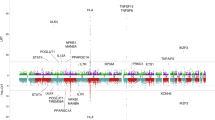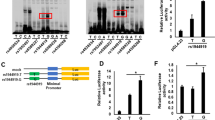Abstract
Susceptibility to primary biliary cirrhosis (PBC) is strongly associated with human leukocyte antigen (HLA)-region polymorphisms. To determine if associations can be explained by classical HLA determinants, we studied Italian, 676 cases and 1440 controls, genotyped with dense single-nucleotide polymorphisms (SNPs) for which classical HLA alleles and amino acids were imputed. Although previous genome-wide association studies and our results show stronger SNP associations near DQB1, we demonstrate that the HLA signals can be attributed to classical DRB1 and DPB1 genes. Strong support for the predominant role of DRB1 is provided by our conditional analyses. We also demonstrate an independent association of DPB1. Specific HLA-DRB1 genes (*08, *11 and *14) account for most of the DRB1 association signal. Consistent with previous studies, DRB1*08 (P=1.59 × 10−11) was the strongest predisposing allele, whereas DRB1*11 (P=1.42 × 10−10) was protective. Additionally, DRB1*14 and the DPB1 association (DPB1*03:01; P=9.18 × 10−7) were predisposing risk alleles. No signal was observed in the HLA class 1 or class 3 regions. These findings better define the association of PBC with HLA and specifically support the role of classical HLA-DRB1 and DPB1 genes and alleles in susceptibility to PBC.
This is a preview of subscription content, access via your institution
Access options
Subscribe to this journal
Receive 6 digital issues and online access to articles
$119.00 per year
only $19.83 per issue
Buy this article
- Purchase on Springer Link
- Instant access to full article PDF
Prices may be subject to local taxes which are calculated during checkout

Similar content being viewed by others
References
Hirschfield GM, Liu X, Xu C, Lu Y, Xie G, Lu Y et al. Primary biliary cirrhosis associated with HLA, IL12A, and IL12RB2 variants. N Engl J Med 2009; 360: 2544–2555.
Liu X, Invernizzi P, Lu Y, Kosoy R, Lu Y, Bianchi I et al. Genome-wide meta-analyses identify three loci associated with primary biliary cirrhosis. Nat Genet 2010; 42: 658–660.
Mells GF, Floyd JA, Morley KI, Cordell HJ, Franklin CS, Shin SY et al. Genome-wide association study identifies 12 new susceptibility loci for primary biliary cirrhosis. Nat Genet 2011; 43: 329–332.
Invernizzi P . Human leukocyte antigen in primary biliary cirrhosis: an old story now reviving. Hepatology 2011; 54: 714–723.
Donaldson PT, Baragiotta A, Heneghan MA, Floreani A, Venturi C, Underhill JA et al. HLA class II alleles, genotypes, haplotypes, and amino acids in primary biliary cirrhosis: a large-scale study. Hepatology 2006; 44: 667–674.
Invernizzi P, Selmi C, Poli F, Frison S, Floreani A, Alvaro D et al. Human leukocyte antigen polymorphisms in italian primary biliary cirrhosis: a multicenter study of 664 patients and 1992 healthy controls. Hepatology 2008; 48: 1906–1912.
Mella JG, Roschmann E, Maier KP, Volk BA . Association of primary biliary cirrhosis with the allele HLA-DPB1*0301 in a German population. Hepatology 1995; 21: 398–402.
Pereyra F, Jia X, McLaren PJ, Telenti A, de Bakker PI, Walker BD et al. The major genetic determinants of HIV-1 control affect HLA class I peptide presentation. Science 2010; 330: 1551–1557.
Cortes A, Brown MA . Promise and pitfalls of the Immunochip. Arthritis Res Ther 2011; 13: 101.
de Bakker PI, McVean G, Sabeti PC, Miretti MM, Green T, Marchini J et al. A high-resolution HLA and SNP haplotype map for disease association studies in the extended human MHC. Nat Genet 2006; 38: 1166–1172.
Salamon H, Klitz W, Easteal S, Gao X, Erlich HA, Fernandez-Vina M et al. Evolution of HLA class II molecules: Allelic and amino acid site variability across populations. Genetics 1999; 152: 393–400.
Karp DR, Marthandan N, Marsh SG, Ahn C, Arnett FC, Deluca DS et al. Novel sequence feature variant type analysis of the HLA genetic association in systemic sclerosis. Hum Mol Genet 2010; 19: 707–719.
Vandiedonck C, Beaurain G, Giraud M, Hue-Beauvais C, Eymard B, Tranchant C et al. Pleiotropic effects of the 8.1 HLA haplotype in patients with autoimmune myasthenia gravis and thymus hyperplasia. Proc Natl Acad Sci USA 2004; 101: 15464–15469.
Noble JA, Valdes AM, Varney MD, Carlson JA, Moonsamy P, Fear AL et al. HLA class I and genetic susceptibility to type 1 diabetes: results from the Type 1 Diabetes Genetics Consortium. Diabetes 2010; 59: 2972–2979.
Wu XM, Wang C, Zhang KN, Lin AY, Kira J, Hu GZ et al. Association of susceptibility to multiple sclerosis in Southern Han Chinese with HLA-DRB1, -DPB1 alleles and DRB1-DPB1 haplotypes: distinct from other populations. Mult Scler 2009; 15: 1422–1430.
Field J, Browning SR, Johnson LJ, Danoy P, Varney MD, Tait BD et al. A polymorphism in the HLA-DPB1 gene is associated with susceptibility to multiple sclerosis. PLoS One 2010; 5: e13454.
Runstadler JA, Saila H, Savolainen A, Leirisalo-Repo M, Aho K, Tuomilehto-Wolf E et al. HLA-DRB1, TAP2/TAP1, and HLA-DPB1 haplotypes in Finnish juvenile idiopathic arthritis: more complexity within the MHC. Genes Immun 2004; 5: 562–571.
Varney MD, Valdes AM, Carlson JA, Noble JA, Tait BD, Bonella P et al. HLA DPA1, DPB1 alleles and haplotypes contribute to the risk associated with type 1 diabetes: analysis of the type 1 diabetes genetics consortium families. Diabetes 2010; 59: 2055–2062.
Bergamaschi L, Leone MA, Fasano ME, Guerini FR, Ferrante D, Bolognesi E et al. HLA-class I markers and multiple sclerosis susceptibility in the Italian population. Genes Immun 2010; 11: 173–180.
Sebastiani GD, Galeazzi M, Tincani A, Scorza R, Mathieu A, Passiu G et al. HLA-DPB1 alleles association of anticardiolipin and anti-beta2GPI antibodies in a large series of European patients with systemic lupus erythematosus. Lupus 2003; 12: 560–563.
Umemura T, Joshita S, Ichijo T, Yoshizawa K, Katsuyama Y, Tanaka E et al. Human leukocyte antigen class II molecules confer both susceptibility and progression in Japanese patients with primary biliary cirrhosis. Hepatology 2012; 55: 506–511.
Gershwin ME, Mackay IR, Sturgess A, Coppel RL . Identification and specificity of a cDNA encoding the 70 kd mitochondrial antigen recognized in primary biliary cirrhosis. J Immunol 1987; 138: 3525–3531.
Lleo A, Bowlus CL, Yang GX, Invernizzi P, Podda M, Van de Water J et al. Biliary apotopes and anti-mitochondrial antibodies activate innate immune responses in primary biliary cirrhosis. Hepatology 2010; 52: 987–998.
Purcell S, Neale B, Todd-Brown K, Thomas L, Ferreira MA, Bender D et al. PLINK: a tool set for whole-genome association and population-based linkage analyses. Am J Hum Genet 2007; 81: 559–575.
Falush D, Stephens M, Pritchard JK . Inference of population structure using multilocus genotype data: linked loci and correlated allele frequencies. Genetics 2003; 164: 1567–1587.
Kosoy R, Nassir R, Tian C, White PA, Butler LM, Silva G et al. Ancestry informative marker sets for determining continental origin and admixture proportions in common populations in America. Hum Mutat 2009; 30: 69–78.
Price AL, Patterson NJ, Plenge RM, Weinblatt ME, Shadick NA, Reich D . Principal components analysis corrects for stratification in genome-wide association studies. Nat Genet 2006; 38: 904–909.
Marchini J, Howie B . Genotype imputation for genome-wide association studies. Nat Rev Genet 2010; 11: 499–511.
Brown WM, Pierce J, Hilner JE, Perdue LH, Lohman K, Li L et al. Overview of the MHC fine mapping data. Diabetes, obesity & metabolism 2009; 11: 2–7.
Browning BL, Browning SR . A unified approach to genotype imputation and haplotype-phase inference for large data sets of trios and unrelated individuals. Am J Hum Genet 2009; 84: 210–223.
Acknowledgements
This study was supported by NIH grants: R01 DK056839, R01DK091823, and K08AR055688 and HYPERGENES (European Network for Genetic-Epidemiological Studies HEALTH-F4-2007-201550).
Author information
Authors and Affiliations
Consortia
Corresponding author
Ethics declarations
Competing interests
The authors declare no conflict of interest.
Additional information
Supplementary Information accompanies the paper on Genes and Immunity website
AppendixThe Italian PBC Genetic Study Group
AppendixThe Italian PBC Genetic Study Group
Piero L. Almasio (Gastroenterology and Hepatology Unit, Di.Bi.M.I.S., University of Palermo, Palermo), Domenico Alvaro (Department of Medico-Surgical Sciences and Biotechnologies, Fondazione Eleonora Lorillard Spencer Cenci, University Sapienza of Rome, Rome), Pietro Andreone (Dipartimento di Medicina Clinica, Università di Bologna, Bologna), Angelo Andriulli (IRCCS Casa Sollievo della Sofferenza Hospital, San Giovanni Rotondo), Cristina Barlassina (Department of Medicine, Surgery and Dentistry, Università degli Studi di Milano, Milan), Antonio Benedetti (Università Politecnica delle Marche, Ancona), Francesca Bernuzzi (Center for Autoimmune Liver Diseases, IRCCS Istituto Clinico Humanitas, Rozzano), Ilaria Bianchi (Center for Autoimmune Liver Diseases, IRCCS Istituto Clinico Humanitas, Rozzano), MariaConsiglia Bragazzi (Department of Medico-Surgical Sciences and Biotechnologies, Fondazione Eleonora Lorillard Spencer Cenci, University Sapienza of Rome, Rome), Maurizia Brunetto (Azienda Ospedaliera Universitaria Pisana, Pisa), Savino Bruno (Department of Internal Medicine, Ospedale Fatebene Fratelli e Oftalmico, Milan), Lisa Caliari (Center for Autoimmune Liver Diseases, IRCCS Istituto Clinico Humanitas, Rozzano), Giovanni Casella (Medical Department, Desio Hospital, Desio), Fabiola Civardi (Center for Autoimmune Liver Diseases, IRCCS Istituto Clinico Humanitas, Rozzano IRCCS Istituto Clinico Humanitas, Rozzano), Barbara Coco (Azienda Ospedaliera Universitaria Pisana, Pisa), Agostino Colli (Department of Internal Medicine, AO Provincia di Lecco, Lecco), Massimo Colombo (Fondazione IRCCS Ca’ Granda, Ospedale Maggiore Policlinico, Milan), Silvia Colombo (Treviglio Hospital, Treviglio), Carmela Cursaro (Dipartimento di Medicina Clinica, Università di Bologna, Bologna), Lory Saveria Croce (University of Trieste and Fondazione Italiana Fegato (FIF), Trieste), Andrea Crosignani (San Paolo Hospital Medical School, Università di Milano, Milan), Francesca Donato (Fondazione IRCCS Ca’ Granda, Ospedale Maggiore Policlinico, Milan), Luca Fabris (University of Padova, Padova), Carlo Ferrari (Azienda Ospedaliero-Universitaria di Parma, Parma), Annarosa Floreani (Dept. of Surgical, Oncological and Gastroenterological Sciences, University of Padova, Padova), Andrea Galli (University of Florence, Florence), Ignazio Grattagliano (Italian College of General Practicioners, ASL Bari), Roberta Lazzari (Department of Surgical, Oncological and Gastroenterological SciencesUniversity of Padova, Padova), Fabio Macaluso (Gastroenterology & Hepatology Unit, Di.Bi.M.I.S., University of Palermo, Palermo), Fabio Marra (University of Florence, Florence), Marco Marzioni (Università Politecnica delle Marche, Ancona), Alberto Mattalia (Santa Croce Carle Hospital, Cuneo), Renzo Montanari (Ospedale di Negrar, Verona), Lorenzo Morini (Magenta Hospital, Magenta), Filomena Morisco (University of Naples, Federico II, Naples), Luca Moroni (Center for Autoimmune Liver Diseases, IRCCS Istituto Clinico Humanitas, Rozzano), Luigi Muratori (Department of Clinical Medicine, University of Bologna, Bologna), Paolo Muratori (Department of Clinical Medicine, University of Bologna, Bologna), Grazia Niro (IRCCS Casa Sollievo della Sofferenza Hospital, San Giovanni Rotondo), Antonio Picciotto (University of Genoa, Genoa), Piero Portincasa (Department of Interdisciplinary Medicine, University Medical School, Bari), Daniele Prati (Ospedale Alessandro Manzoni, Lecco, Fondazione IRCCS Ca’ Granda, Ospedale Maggiore Policlinico, Milan), Cleofe Prisco (Ospedale Niguarda, Milan), Floriano Rosina (Division of Gastroenterology & Hepatology, Center for Predictive Medicine, Gradenigo Hospital, Turin), Sonia Rossi (Department of Internal Medicine, Ospedale Fatebene Fratelli e Oftalmico, Milan), Carlo Selmi (IRCCS Istituto Clinico Humanitas, Rozzano), Giancarlo Spinzi (Azienda Ospedaliera Valduce, Como), Mario Strazzabosco (Yale University, New Haven, Connecticut 06511, USA and University of Milan-Bicocca, Monza), Sonia Tarallo (Division of Gastroenterology and Hepatology, Center for Predictive Medicine, Gradenigo Hospital, Turin), Claudio Tiribelli (University of Trieste and Fondazione Italiana Fegato (FIF), Trieste), Pierluigi Toniutto (University of Udine, Udine), Maria Vinci (Ospedale Niguarda, Milan), Massimo Zuin (San Paolo Hospital Medical School, Università di Milano, Milan).
Rights and permissions
About this article
Cite this article
Invernizzi, P., Ransom, M., Raychaudhuri, S. et al. Classical HLA-DRB1 and DPB1 alleles account for HLA associations with primary biliary cirrhosis. Genes Immun 13, 461–468 (2012). https://doi.org/10.1038/gene.2012.17
Received:
Revised:
Accepted:
Published:
Issue Date:
DOI: https://doi.org/10.1038/gene.2012.17
Keywords
This article is cited by
-
HLA imputation and its application to genetic and molecular fine-mapping of the MHC region in autoimmune diseases
Seminars in Immunopathology (2022)
-
How genetic risk contributes to autoimmune liver disease
Seminars in Immunopathology (2022)
-
Role of cell autophagy in the generation of IgM and hepatic fibrosis in primary biliary cholangitis
Clinical Rheumatology (2020)
-
Principal contribution of HLA-DQ alleles, DQB1*06:04 and DQB1*03:01, to disease resistance against primary biliary cholangitis in a Japanese population
Scientific Reports (2017)
-
Primary biliary cholangitis: a comprehensive overview
Hepatology International (2017)



